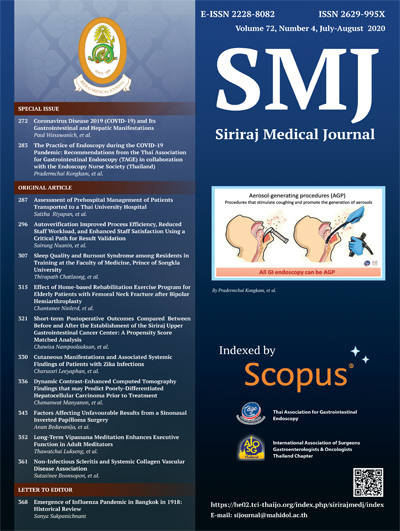Dynamic Contrast-Enhanced Computed Tomography Findings that may Predict Poorly-Differentiated Hepatocellular Carcinoma Prior to Treatment
DOI:
https://doi.org/10.33192/Smj.2020.45Keywords:
Computed tomography, histological differentiation, poor differentiation, hepatocellular carcinomaAbstract
Objective: To identify CT findings that predict poorly-differentiated hepatocellular carcinoma (p-HCC).
Methods: This retrospective study included pathologically proven HCC patients during January 2010 to December 2017 who underwent dynamic contrast-enhanced computed tomography (CT) imaging within 12 weeks before the pathological diagnosis. CT findings were reviewed and graded by consensus opinion of two abdominal radiologists. The relationship between imaging findings and histological differentiation of HCC was analyzed using chi-square test. Sensitivity, specificity, positive predictive value (PPV), negative predictive value (NPV), and accuracy for diagnosis of p-HCC were calculated.
Results: Of 200 HCCs during the study period, 18 were well-differentiated, 170 were moderately-differentiated, and 12 were poorly differentiated. Irregular rim enhancement in arterial phase (p<0.001) and presence of lymphadenopathy (p=0.003) were both statistically significantly different among the three types of histological differentiation of HCC. Sensitivity, specificity, PPV, NPV, and accuracy for prediction of p-HCC by the presence of irregular rim enhancement in arterial phase and lymphadenopathy were 58.3%, 97.3%, 58.3%, 97.3%, and 95%, and 50%, 88.8%, 22.2%, 96.5%, and 86.5% - all respectively.
Conclusion: The presence of irregular rim enhancement in arterial phase and lymphadenopathy are potentially useful CT findings for prediction of p-HCC prior to treatment.
References
2. Yu SJ. A concise review of updated guidelines regarding the management of hepatocellular carcinoma around the world: 2010-2016. Clin Mol Hepatol 2016;22:7-17.
3. Raza A, Sood GK. Hepatocellular carcinoma review: current treatment, and evidence-based medicine. World J Gastroenterol 2014;20:4115-27.
4. Marrero JA, Kulik LM, Sirlin CB, Zhu AX, Fin RS, Abecassis MM, et al. Diagnosis, staging, and management of hepatocellular carcinoma: 2018 practice guidance by the American Association for the Study of Liver Disease. Hepatology 2018;68:723-50.
5. Forner A, Llovet JM, Bruix J. Hepatocellular carcinoma. Lancet 2012;379:1245-55.
6. Tamura S, Kato T, Berho M, Misiakos EP, O'Brien C, Reddy KR, et al. Impact of histological grade of hepatocellular carcinoma on the outcome of liver transplantation. Arch Surg 2001;136:25-30.
7. Oishi K, Itamoto T, Amano H, Fukuda S, Ohdan H, Tashiro H, et al. Clinicopathologic features of poorly differentiated hepatocellular carcinoma. J Surg Oncol 2007;95:311-6.
8. Kim SH, Lim HK, Choi D, Lee WJ, Kim MJ, Kim CK, et al. Percutaneous radiofrequency ablation of hepatocellular carcinoma: effect of histologic grade on therapeutic results. AJR Am J Roentgenol 2006;186:S327-S33.
9. Imamura J, Tateishi R, Shiina S, Goto E, Sato T, Ohki T, et al. Neoplastic seeding after radiofrequency ablation for hepatocellular carcinoma. Am J Gastroenterol 2008; 103:3057-62.
10. Takada Y, Kurata M, Ohkohchi N. Rapid and aggressive recurrence accompanied by portal tumor thrombus after radiofrequency ablation for hepatocellular carcinoma. Int J Clin Oncol 2003;8:332-5.
11. Fukuda S, Itamoto T, Nakahara H, Kohashi T, Ohdan H, Hino H, et al. Clinicopathologic features and prognostic factors of resected solitary small-sized hepatocellular carcinoma. Hepatogastroenterology 2005;52:1163-7.
12. Lee JH, Lee JM, Kim SJ, Baek JH, Yun SH, Kim KW, et al. Enhancement patterns of hepatocellular carcinomas on multiphasicmultidetector row CT: comparison with pathological differentiation. Br J Radiol 2012;85:e573-83.
13. Nakachi K, Tamai H, Mori Y, Shingaki N, Moribata K, Deguchi H, et al. Prediction of poorly differentiated hepatocellular carcinoma using contrast computed tomography. Cancer Imaging 2014;14:7-12.
14. Asayama Y, Yoshimitsu K, Nishihara Y, Irie H, Aishima S, Taketomi A, et al. Arterial blood supply of hepatocellular carcinoma and histologic grading: radiologic-pathologic correlation. AJR Am J Roentgenol 2008;190:W28-W34.
15. Kawamura Y, Ikeda K, Hirakawa M, Yatsuji H, Sezaki H, Hosaka T, et al. New classification of dynamic computed tomography images predictive of malignant characteristics of hepatocellular carcinoma. Hepatol Res 2010;40:1006-14.
16. Yoon SH, Lee JM, So YH, Hong SH, Kim SJ, Han JK, et al. Multiphasic MDCT enhancement pattern of hepatocellular carcinoma smaller than 3 cm in diameter: tumor size and cellular differentiation. AJR Am J Roentgenol 2009;193:W482-9.
17. Seo N, Kim DY, Choi JY. Cross-sectional imaging of intrahepatic cholangiocarcinoma: development, growth, spread, and prognosis. AJR Am J Roentgenol 2017;209:W64-75.
18. Ganeshan D, Szklaruk J, Kundra V, Kaseb A, Rashid A, Elsayes KM. Imaging features of fibrolamellar hepatocellular carcinoma. AJR Am J Roentgenol 2014;202:544-52.
19. Katyal S, Oliver JH 3rd, Peterson MS, Ferris JV, Carr BS, Baron RL. Extrahepatic metastases of hepatocellular carcinoma. Radiology 2000;216:698-703.
20. Lee CW, Chan KM, Lee CF, Yu MC, Lee WC, Wu TJ, et al. Hepatic resection for hepatocellular carcinoma with lymph node metastasis: clinicopathological analysis and survival outcome. Asian J Surg 2011;34:53-62.
Downloads
Published
How to Cite
Issue
Section
License
Authors who publish with this journal agree to the following conditions:
Copyright Transfer
In submitting a manuscript, the authors acknowledge that the work will become the copyrighted property of Siriraj Medical Journal upon publication.
License
Articles are licensed under a Creative Commons Attribution-NonCommercial-NoDerivatives 4.0 International License (CC BY-NC-ND 4.0). This license allows for the sharing of the work for non-commercial purposes with proper attribution to the authors and the journal. However, it does not permit modifications or the creation of derivative works.
Sharing and Access
Authors are encouraged to share their article on their personal or institutional websites and through other non-commercial platforms. Doing so can increase readership and citations.















